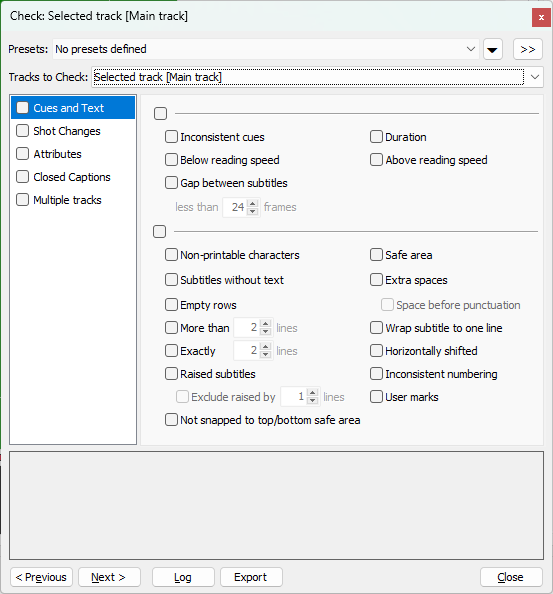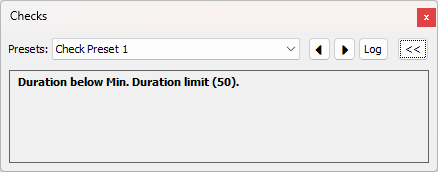Once the subtitles are finished, you may want to verify there aren't any errors left behind. The Checks command will help you to locate all subtitles that doesn't match certain rules.
To open the Checks press the Check Subtitles button on the toolbar or alternatively click on Check Subtitles in the Titles drop-down menu.

Detailed description of the particular Check options/criteria available in each category can be found in the following topics:
The available Checks criteria are divided into separate categories for easier navigation and clean preview of the selected options. Whenever there is at least one option selected for a category, category's name would be marked in bold and the checkbox in front of it will look like a square - ![]() . And when all options are clicked for a category, the checkbox in front of its name becomes fully checked -
. And when all options are clicked for a category, the checkbox in front of its name becomes fully checked - ![]() .
.
The text specifying the type of the error found in the current subtitle is displayed at the bottom of the window. You can find the next problematic subtitle using the Next and Previous buttons or by assigning shortcuts for the Check Next and Check Previous commands.
Subtitles matching the selected criteria could then be send to the Log List or be Moved to a new track. The exact action can be selected from the drop-down menu under the Log button.
The Export button will create MS Excell file containing the subtitles with found issues, subtitles without problems will not be exported, and details about the issues. Please mind that when working with projects with two tracks, subtitles from the secondary track will be exported into separate worksheet in the MS Excel document.
For projects with more tracks, Check Subtitles can be started for the selected (Default), Main or Secondary tracks or both Main & Secondary tracks at the same time. And, in addition the Filter drop-down allows you to run Fix Subtitles for selected number of subtitles only.
You can edit subtitles while using the Checks. The Checks dialog will remain open and will be updated with every change you make so that you can monitor the effects of your actions.
Creating Check Presets
EZTitles also provides the functionality to create Presets with the most frequently used "Check" options.
To add new preset you can simply press the triangular button ![]() and select the Create New Preset option. All currently selected "Check" options will be added for this preset. To modify the currently selected preset you just need to click the "Check" options you want to activate or disable and then select the Save current preset option after clicking the triangular button. From the same menu you can also Delete or Rename the currently activated preset.
and select the Create New Preset option. All currently selected "Check" options will be added for this preset. To modify the currently selected preset you just need to click the "Check" options you want to activate or disable and then select the Save current preset option after clicking the triangular button. From the same menu you can also Delete or Rename the currently activated preset.
You can select another of your "Check" Presets directly from the Presets drop-down menu.
Note: Pressing the ![]() button next to Presets will hide the main part of the Checks form leaving only the part describing what the particular problem is:
button next to Presets will hide the main part of the Checks form leaving only the part describing what the particular problem is:

This will be really helpful when EZTitles is used on devices with small display running at low resolution and high DPI settings.